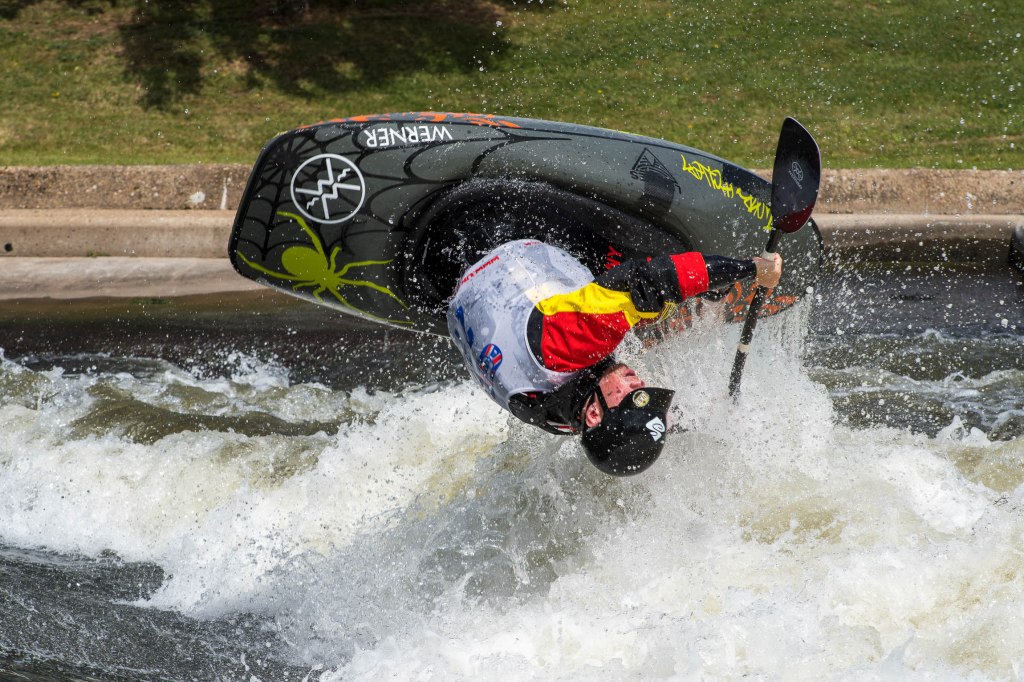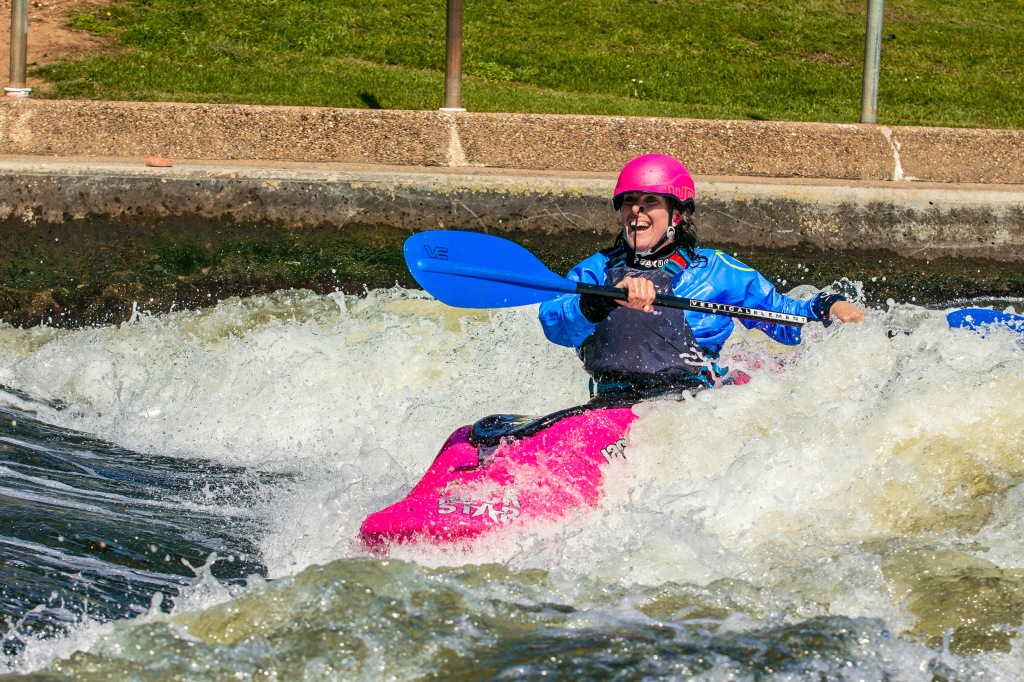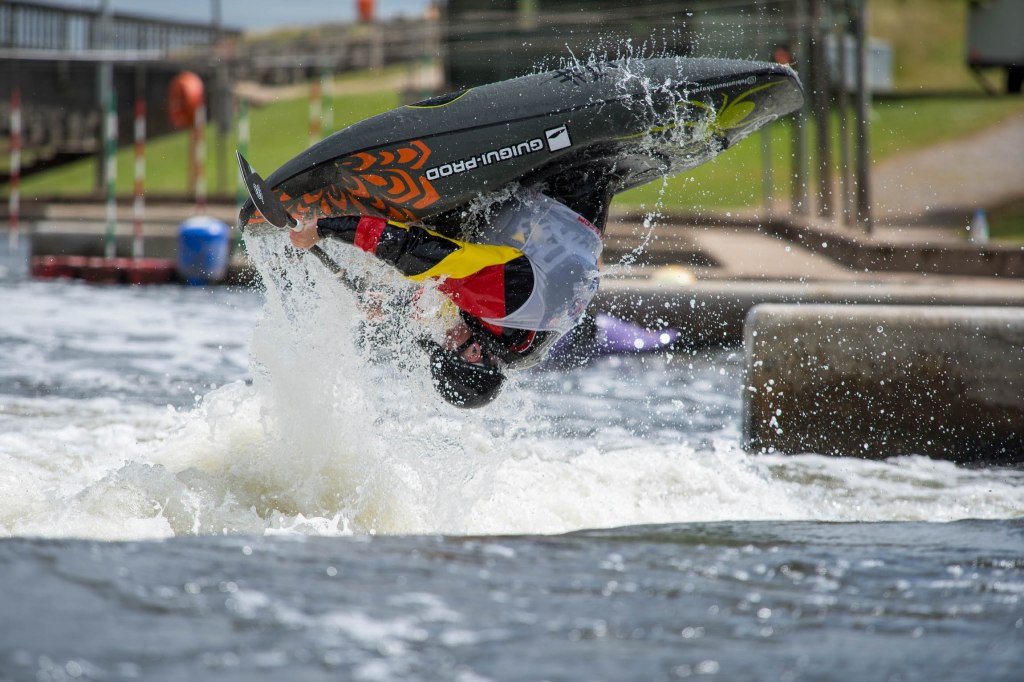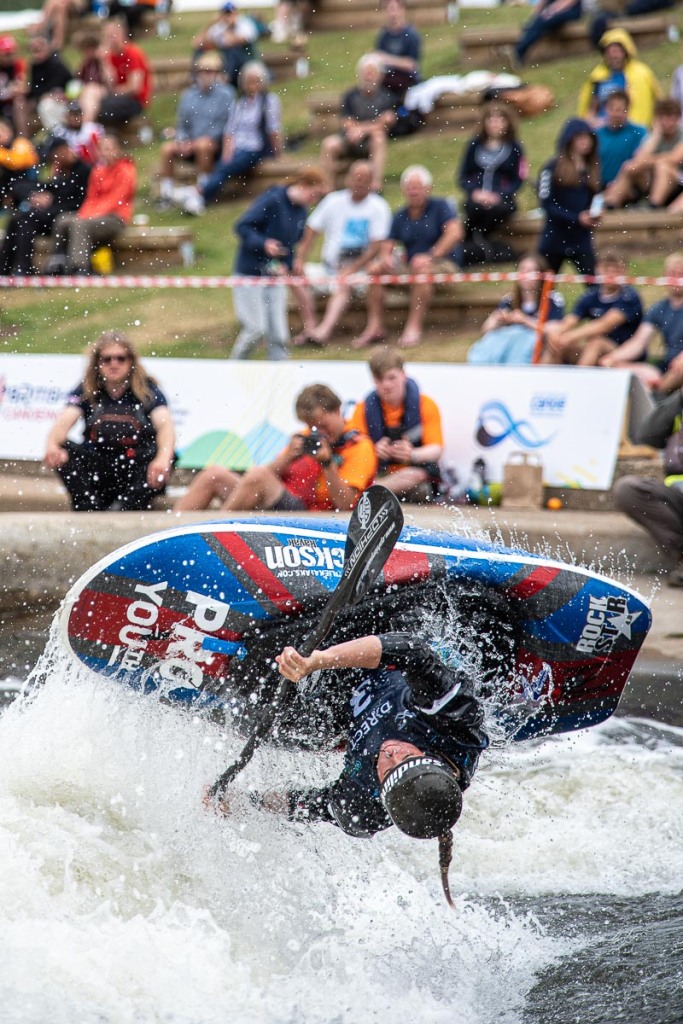Some get it, some don’t. Here’s why freestyle canoeing and kayaking is good for you, no matter what your experience level is.
Freestyle is one of those disciplines that is hard to grasp for newcomers. I remember when I first came across it and because I wasn’t familiar with what the boaters were doing, I couldn’t see where the skill was. It looked like stylised capsizing. Recently, this impression was brought back to me when I showed someone who wasn’t a kayaker a clip of one of the UK’s best freestyle kayakers practicing at Nottingham. He said to me that if he was physically there he thought he’d have to watch for a bit to make sure the kayaker wasn’t in trouble!
In other words, to the unfamiliar, freestyle kayaking can look like uncontrolled flailing around in a hole! I doubt the person in question would have that same impression if they were watching someone on Garb wave or similar, since wave moves are generally much more obvious and stylish. In the UK the majority of good freestyle features tend to be holes, so the opportunities for doing blunts and air screws are not as great, which is why US paddlers are generally better at waves, while UK boaters excel at holes.
Even when a beginner kayaker can see the skill of a great hole boater like Harry Price and Ottilie Robinson Shaw, they often think that freestyle is something you only start when you are more advanced. This couldn’t be more wrong. If I could go back and start my boating all over again, I’d tell my past self to take up freestyle as quickly as possible.

I’ve said this elsewhere, but if you look at any of the great current kayakers doing the rounds at the moment, from Dane Jackson to Bren Orton to Aniol Serrasolses to name three from a vast list, they all got their start in freestyle. For kids, freestyle is a great way to start and build up huge amounts of skill, boating confidence and control. The same applies to adults, too.
Adults tend to learn more slowly than children, and they also have more psychological blocks. Visit any kayak club anywhere in the world, and one of the greatest fears anyone has there is a failed roll. Pool sessions take place and people practice their rolls over and over, usually on one side, and usually from a setup position. And yet the best way to improve your roll is in a safe environment and from going over unpredictably in any number of positions.
Freestyle meets this criteria very well, even if all you are physically able to do is a flat spin on a wave. It doesn’t matter whether you are striving to be the next Dane Jackson or simply to be able to front surf, freestyle is fun, and you will go over a lot. Going upside down is a part and parcel of it, and indeed it’s pretty much the entire point in many ways. And that means you end up using your roll again and again.

Bombproof roll
In another story I’ve recalled many times before, my wonderful Em was lacking confidence in her roll when I first met her, and she swam a fair amount. She took over my Dagger G-Force, an older style playboat, and we went to CIWW in Cardiff every week to play around on the bottom wave there. It just pools out so there’s no horrible swim, and in the summer the water is bath tub warm. In the space of two to three weeks, her roll went from being hit and miss to being an 80-90% hit rate, and it only increased from there.
Not only did her roll improve, but so too did her confidence and familiarity with being in a more chunky feature than she was used to. It lit a fire in her that eventually led to our Uganda trip as well as going in for some fun competitions where we pretty much just capsized the whole time without being able to do any actual tricks. It’s just so enormously tragic that we will never be able to embark on such adventures ever again. But if I can use Em’s example to show how doing some freestyle can really help you progress exponentially as a paddler, even if you are a beginner, to persuade someone to try it, then that will be a great thing.

Here’s a bullet list of what you’ll get out of freestyle:-
- Confidence boost
- Confidence in your ability to roll
- More relaxed in your boat in all sorts of water
- Improved balance
- Improved boat control
- Much better edge and body position awareness
- It’s a physical workout
- You can go boating when nobody else is free or available
- No group faff
- You can surf the boats at the beach and try tricks
- A bigger smile on your face than someone who isn’t doing freestyle
- Ability to make more use of low summer water flows, and even flat water if that’s all you have close to home
- Boat fits easily in the boot of the car
- Might make you start bringing shorts to the river while everyone else is in a drysuit
Are there any negatives to freestyle? It depends what you term a ‘negative’. Okay, if you want to learn specific tricks like loops it can be frustrating. But the thing here is to look upon learning those things as a fun journey. You’ll be getting plenty of capsize and roll practice along the way! The other thing is that it can be very addictive. You also get to find out which dry gear is actually dry and therefore end up being a bit finicky over your preferred brands.
But, more seriously, the earlier you can begin to do some play boating in your kayaking journey, the faster you’ll progress as a whole.
Winter is one of the best times to start freestyle
At first, if you’re fairly new to kayaking, you’ll have those same fear pangs that you have in your other boat about going upside down and swimming, which is why winter is a great time to start it. Say what?! I am serious, but, of course, I’m referring to nice warm pool sessions rather than taking an axe with you to break the ice on a river.
A regular pool session is a great time to start freestyle for many reasons. The first is that it breaks the monotony of just trying endless rolls from setup. It gives you realistic scenarios to roll up from because it is an actual live scenario. Playboats take up much less room in a swimming pool, too. You’ll start to give the evil eye to people who bring creek boat barges with them. With the sheer amount of roll practice you’ll get, it will set you up well for both your winter trips, and any summer trips abroad you might be planning the following year. Yes, you’ll swim a lot at first if your roll is hit and miss, but that will soon change!
One of the great things about pool sessions is if there’s a few of you wanting to do it, it spurs everyone on. You can challenge each other to try things out, give feedback, and just generally encourage each other to keep giving stuff a go.
Common excuses not to do freestyle
1. I’m not flexible enough
This is a common one from paddlers in their 40s and above. As someone who is themselves well into their 40s and who has let their fitness slide, it’s a pretty poor excuse too. The body is very good at adapting to movement, so the more you do something, the more your body will accommodate it. So although you may be stiff and inflexible to start with, that will change. Besides, flexibility isn’t that much of a pre-requisite to start out anyway.
2. It looks like too much work
Well yeah. It’s a physical workout for sure. But that just makes you stronger and fitter.
3. I keep seeing you doing the same moves over and over. Isn’t that boring?
No, it isn’t. But in any case, I’m trying to learn specific moves and I’m also trying to learn the full mechanics of what makes them work. But you don’t have to. If you don’t want to make perfect moves and just want to have as much fun as possible, then that’s just as valid as trying to make stuff as neat as possible. Freestyle is something that you make your own. If that’s just doing tailies or surfing a wave, or just doing what you can to throw the boat around on the flat, then it’s all good. I will say that there’s a huge feeling of satisfaction and achievement if you have practiced something specific over and over and then finally nail it, though.
4. Another new boat is expensive
Yep, they are. But you don’t need a brand new high performance boat to do this. There are plenty of great freestyle boats on the used market, from Jitsus to Rock Stars, and even some of the older ones. In fact if you have no ambition to loop, but you’d love to cartwheel, some of the older full slice designs might suit you better.

5. It looks silly
You don’t know what you’re missing and nobody likes you.
5. It’s a very niche subset of kayaking
Yes, it is. But the same can be said of white water kayaking in general. Freestyle has real benefits for your river running. There’s the roll, which I’ve already mentioned, but it also makes you better able to handle features, and gives you much more of a toolset should you get stuck in a side surf in a sticky hole in your big boat, which will happen at some point. Furthermore, sometimes you do need to paddle your playboat to a feature. This is where you become super aware of edges and body position, because you can’t get away with the lazy postures that you can in a bigger boat.
Some say that paddling playboats can build bad habits for general paddling strokes, but I don’t believe that is the case. I tend to paddle my freestyle boat with the same awareness of paddle strokes as my bigger boat.
6. It’s just for youngsters
Not a chance of it! There are people well into their 50s with heart bypasses who regularly do freestyle, and have become pretty damn good at it! Eric Jackson is 58, and Steven Wright and Clay Wright (not related) are of a similar age and they still compete at a high level.
7. But I want to be running chunky creeks and waterfalls, doing real whitewater kayaking, not this tricky mamby pamby left wing woke short stumpy boat play stuff!
That’s fine. But ask yourself where guys like Bren Orton learnt how to kick flip over waves, surf, or deal with being stuck in a tough hole if they make a mistake. If you live in a place where you can walk from your front door all the time and find a nice class IV or V that runs regularly, okay. Most people don’t, and you’ll be thankful for many of the skills freestyle gives you during times when you can’t run that stuff once you’re on such runs. If you want a good advertisement for ‘real’ whitewater kayakers doing freestyle, look no further than Dane Jackson. Or Adrian Mattern. Or Adriene Levknecht. Or Nouria Newman. Or Aniol Serrasolses. Or Kalob Grady. Or Benny Marr. Or Emily Jackson.
Name me a top international white water kayaker and you can bet money that they either started in freestyle or they took it up later to broaden their skills.

Conclusions
I’m sometimes perplexed by the resistance that some people put up against trying out play boating. When that resistance comes from someone with more experience I think it can emanate from a position of not wanting to feel like a beginner again. It can also transpire that there’s a lack of confidence in their roll, even amongst people who have been paddling a few years; getting into a playboat will quickly highlight any deficiencies. It’s incredible how many river boaters lack roll confidence and can only roll on one side. Getting to a certain skill level and feeling like you’ve left those beginner days behind you can make starting something new a difficult pill to swallow for some. In clubs, even ending up needing to roll is sometimes classed as a mistake that needs highlighting in the trip report. Sometimes I’ve known people beat themselves up for merely going over and having to roll during a trip. I was once that person.
With freestyle you’re doing something wrong if you’re not going over a lot. Even going down a white water river run in a playboat, going upside down is just to be expected occasionally. It’s not uncommon to simply get flipped by a boil or recirculating current at a place like Nottingham or Cardiff for example. I was once inadvertently put into a bow stall simply by sitting in an eddy at HPP!
Simply, freestyle eliminates those sorts of hangups. Expect to get absolutely drenched, because it’s part of the programme.
If you do a lot of pool sessions during the winter, taking up freestyle will help you progress far, far more quickly than just practising endless rolls from set up or from forward paddling. In the summer when there are no white water trips it will open up a lot more possibilities for you and make things more interesting. In general it will build your confidence and boating skill in ways that just aren’t possible in a big boat unless you go on really big white water. Particularly if you don’t have regular access to decent white water. There’s something really awesome about being able to turn up to a wave or a hole feature, take the boat out of the car and just mess around for a while on a warm sunny day or evening. No group faff, no pressure, just pure joy.


That is a fabulous photo of Emily. I was so sorry to read of your loss in August.
Another great article and it’s an excellent tip to focus on a feature like the bottom wave at CIWW where there’s little or no consequence to going upside down. I’m going to try that next time I’m there.
Best wishes.
Thanks Tim. It’s a rocky road dealing with her loss, but I’m taking things day by day. Really glad you liked the article. The bottom wave at Cardiff is such a great place to gain confidence with going over a lot.